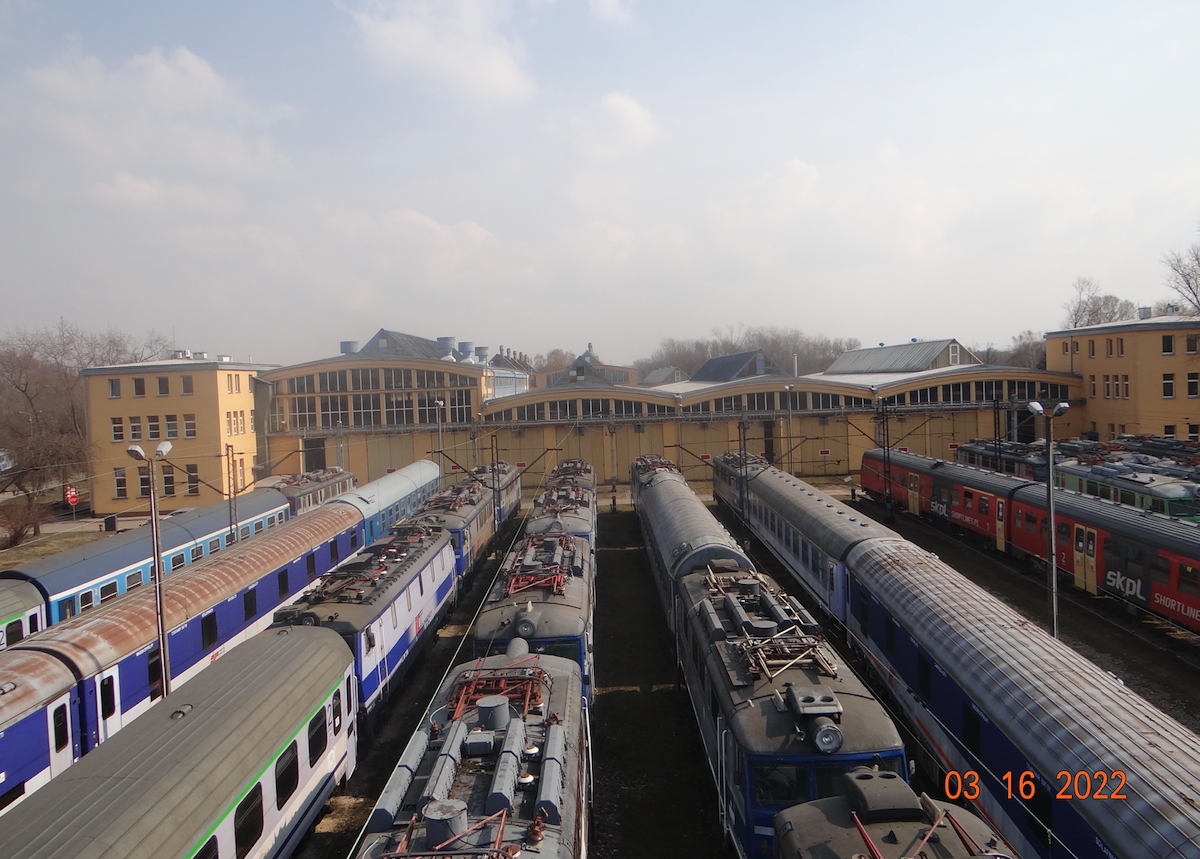Kraków 2022-03-29
History of PKP Kraków Junction.
The railway has been associated with Kraków since 1847, i.e. for 175 years. During this period, the railway has expanded and changed significantly. And this dynamic state continues. In this chapter, we will try to present the history of the technical support of the Kraków railway junction.
From Płaszów to Bieżanów.
The railway support in Kraków developed along the railway route from Kraków Płaszów station (initially called Podgórze) to Bieżanów station (initially written with “rz” Bierzanów). The entire railway complex is 6,300 m long, up to 330 m wide and has an area of 210 hectares. There are three passenger railway stations in this area; Kraków Płaszów, Kraków Prokocim and Kraków Bieżanów. But above all, there are freight stations, locomotive sheds, rolling stock repair plants and other infrastructure.
Since it is difficult to arrange all the plants in chronological order, we will discuss them one by one, according to their geographical location from west to east. We will start with the Polish Railway Workers Memorial. Near the Kraków Płaszów station there is a monument commemorating the martyrdom of seven Polish Railway Workers brutally hanged by the Germans on June 26, 1942. Every year, the railway workers meet at the monument. The monument stands at the intersection of Prokocimska and Wodna streets.
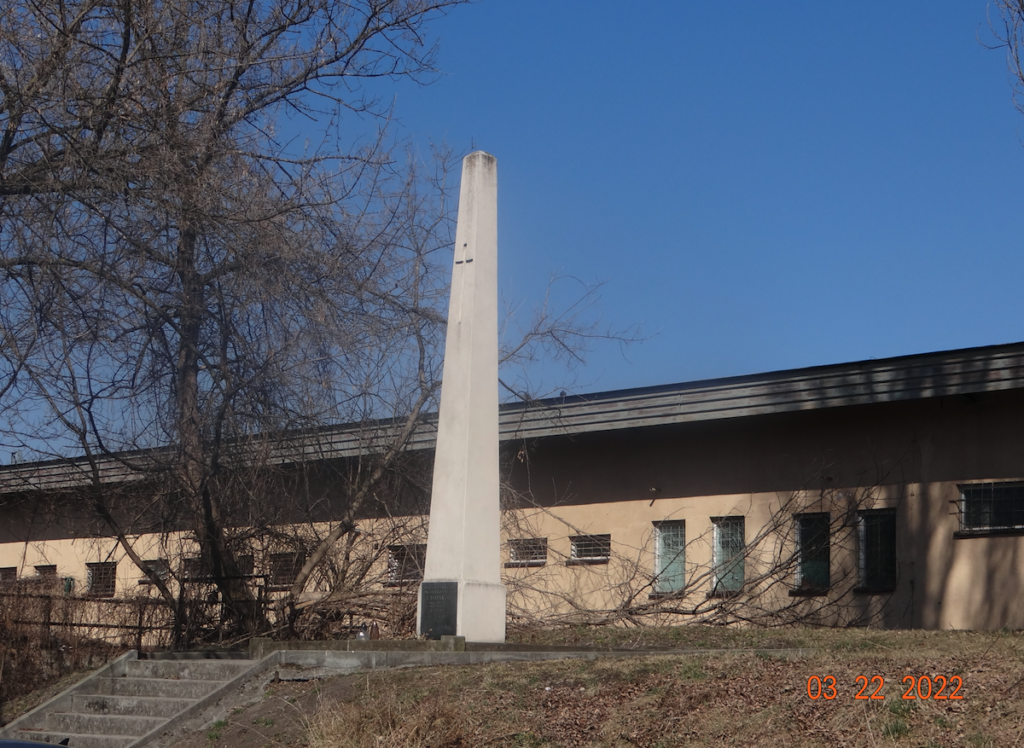
Traffic maintenance department.
At the Kraków Płaszów station there is a traffic maintenance department for EZT Koleje Małopolskie and PolRegio trains. The department is located in the southwestern part of the station. Geographic coordinates 50.037N 19.970E. There are four impassable tracks here. The administration occupies a historic building and a barrack. Between these buildings there is a new modern computer signal box, launched in 2021. The signal box was placed opposite, on the other side of the main tracks, the former signal box, which is no longer used. The new signal box cooperates with the Kraków Główny and Kraków Bonarka signal boxes.
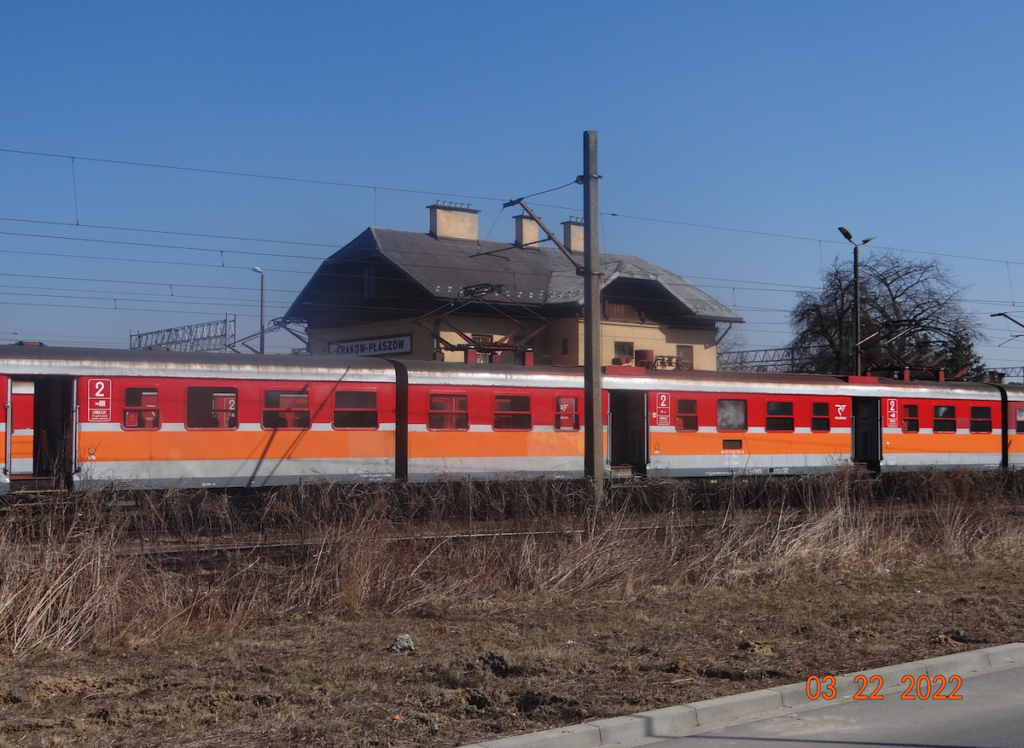
Photo description: In the foreground, the modernized EZT EN57 of the PolRegio carrier. In the background, the oldest building at the Kraków Płaszów station.
Next to the department’s tracks, there is a memento of the German occupation from 1939-1945. It is a barrier, a reinforced concrete pole, which, if necessary, was to be turned over onto the tracks to block them. If this is true, there should be several such poles. Officially, there is information about one more, which is no longer there. The standing barrier shows that the two nearby tracks could have been passable. The barrier can be viewed from Prokocimska Street.
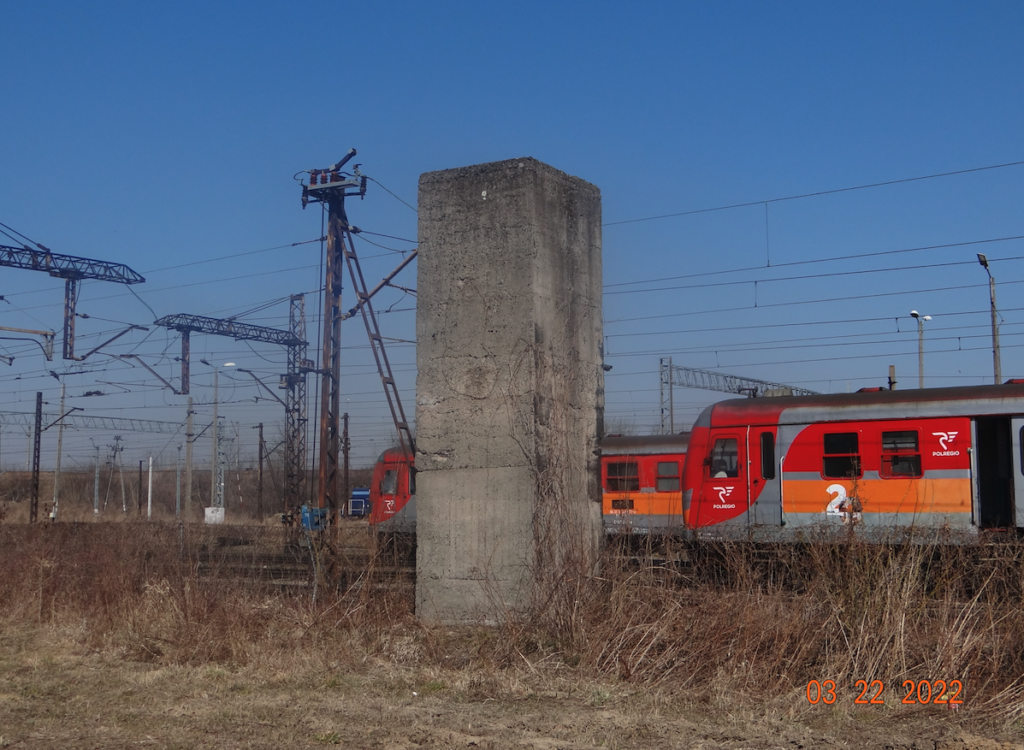
Krakow Płaszow passenger station.
Krakow Płaszow passenger station is discussed in other chapters.
Krakow Płaszow locomotive shed.
Now we are moving to the southern – western part of the Krakow Płaszow station (then called Podgórze station), where the Polish Post Office building currently stands. Geographic coordinates 50.032N 19.978E. A large locomotive shed operated at the Krakow Główny station. But freight and passenger transport in Western Galicia systematically increased. That is why the first locomotive shed was built in Płaszow. The locomotive shed mainly serviced locomotives running on the route to Sucha (currently Sucha Beskidzka). This was in 1884. The locomotive shed had a turntable, a shed, workshops and a water tower. The fan shed initially had four stations, and then four more stations were added. In the following years, the facility was expanded under the name Lokomotywownia Wola Duchacka.
Further railway facilities were built to the east. Wagon repair workshops belonging to the CLB (Carl Ludwig Bahn) railway were built. This was around 1900. Later, the workshops were nationalized and taken over by kkStb. The workshops serviced wagons running on the Kraków – Lviv route.
In the 1990s, the locomotive shed facilities were dismantled. The building of the Polish Post Office was erected in this place, built in 1998. The Polish Post Office had its own siding and its own wagons. Currently (2022) there is no siding, and all postal wagons have been sold.
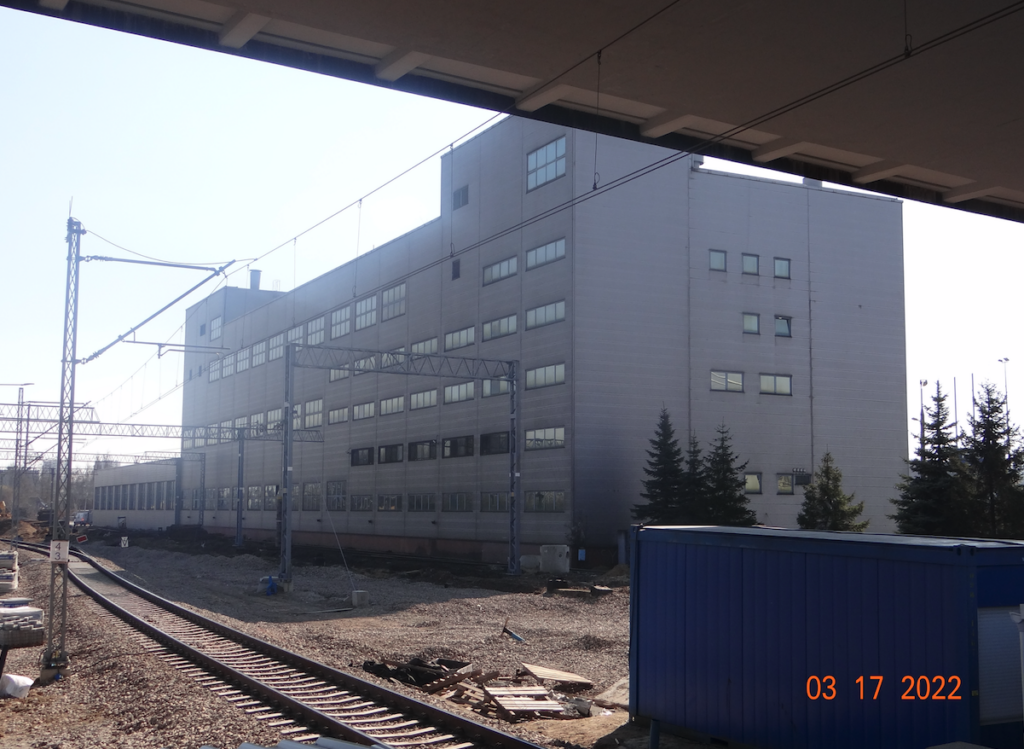
Krakow Cable Factory.
In 1927, a joint-stock company was established – Krakow Cable and Cable Machinery Factory in Krakow. At that time, Poland had four cable factories: Bydgoszcz, Warsaw, Ożarów and Krakow. The company in Krakow began operating in 1928. The factory was built in one year, between today’s Wielicka Street and the railway tracks of the Krakow Płaszów station. In addition, the factory had small factory buildings in Borek Fałęcki. The factory in Płaszów was very modern. There were numerous railway sidings on the factory premises. Raw materials were delivered and products were exported by rail. Cables were also transported by wagons to the river port on the Vistula in Płaszów.
Another locomotive shed.
The locomotive shed in Płaszów quickly turned out to be small. Therefore, in 1908, a new locomotive shed was built between Płaszów and Prokocim, at Kolejowa Street. Geographic coordinates 50.027N 19.986E. The locomotive shed still stands today. It was one of the largest complexes of locomotive sheds and rolling stock repair workshops in the region. The locomotive shed is double, fan-shaped. Each shed had its own turntable. There were 16 stands in each shed. In 1920, 100-120 steam locomotives were stationed in Płaszów. At that time, the mechanical workshops were expanded. Since then, general repairs of steam locomotives have been carried out in Płaszów, with the exception of boiler repairs. The boilers were manufactured by the boiler factory in Sosnowiec. In 1927, the locomotive shed was expanded to meet the needs of the Polish State Railways. Administrative and technical facilities were built. A new oval water tower with two tanks was built. The northern shed was expanded to its maximum size.
In 1942, during the German occupation, another rectangular shed with eight stands was built. After World War II, this shed was intended for electric locomotives. Electric locomotives are still serviced here.
In 1962, steam locomotive service ended at Kraków Główny station. All steam locomotives were transferred to Płaszów, Chabówka and other locomotive depots.
In 1970, steam locomotive service ended at the Kraków junction. One of the last trains serviced by steam locomotives was the night train Kraków Główny – Hrubieszów, which from Rzeszów traveled on a non-electrified route. The train was pulled by a steam locomotive, usually a Ty45 manufactured by HCP / FABLOK or a Ty51 manufactured by HCP. These were locomotives manufactured after World War II. In the following years, the train was pulled by ET21 electric locomotives to Rzeszów, and ST43 diesel locomotives from Rzeszów.
In 1972, due to the liquidation of the Kraków Główny locomotive shed, diesel and electric locomotives were serviced in Płaszów. Diesel locomotives in Płaszów were serviced until 2009, which is why for several years old ST43 and ST44 locomotives could be seen on the holding tracks. PKP Cargo decided to transfer the servicing of diesel locomotives to another locomotive shed.
In Płaszów, the northern shed was the first to stop working. Then the southern and rectangular sheds lost their purpose.
In 2011, the rectangular shed was reopened. The rectangular hall was taken over by the Regional Transport Company in Kraków, which performs inspections of electric multiple units (EZT) there. Address: Kolejowa Street 4a.
Currently (2022), companies not related to the railway operate in the locomotive shed. “Horeca Service Rental, Kolejowa, Kraków” – catering equipment rental. “Omniloko spółka” – repair and maintenance of machines. Currently (2018), wrecks of old steam locomotives stand on the locomotive shed, including: Ty51, Pt47 and old wagons. The unused oval water tower stands to this day. The water crane is also preserved, by the sheds.
Kraków – Prokocim Freight Station.
In the period 1914-1916, a large railway marshalling yard was built (for Austrian needs), which was enlarged during World War II (for German needs), and then after 1949, for the needs of the Polish economy. The station was built next to the Bagry Reservoir and at today’s Kolejarzy Street. Currently, there are 15 tracks here. There is even an island passenger platform with a roof. The platform is 220 m long, and the roof is 70 m long. A marshalling hump was built at the station. Overhead cranes and cranes were erected and storage yards were marked out. The current name is the Kraków – Prokocim Goods Station. Nearby there are buildings occupied by the companies PKP Polskie Linie Kolejowe and PKP Cargo transport section. Next to the buildings of the PKP Cargo transport section, there is a footbridge over the tracks. The footbridge is about 70 m long. The footbridge is made of steel, of a truss type. Nearby is a railway station.
Another level with haulage tracks is the so-called scrapyard of old locomotives. There are 10 tracks here, on which unused locomotives stand. 10 years ago there were many diesel locomotives of the ST43 type here. There were electric locomotives EU07, ET41 and passenger cars here. Currently, the most common are ET22 locomotives, which are in historical green colours.
Behind the holding tracks there is another station level, the largest of all. It has about 30 tracks, and the length of the station level is 1,300 m. The station houses the longest freight trains. On the southern side there is another station level, the tracks of which have been dismantled. Currently, it is a storage yard of the “Strabag” company, which carries out repairs of tracks and other railway infrastructure.
To the east there is a large technical base with a water tower and a coal elevator, which we wrote about below. On the northern and southern sides there are other station levels.
The entire complex is closed by the Kraków Prokocim Locomotive Depot and smaller companies from the railway industry.
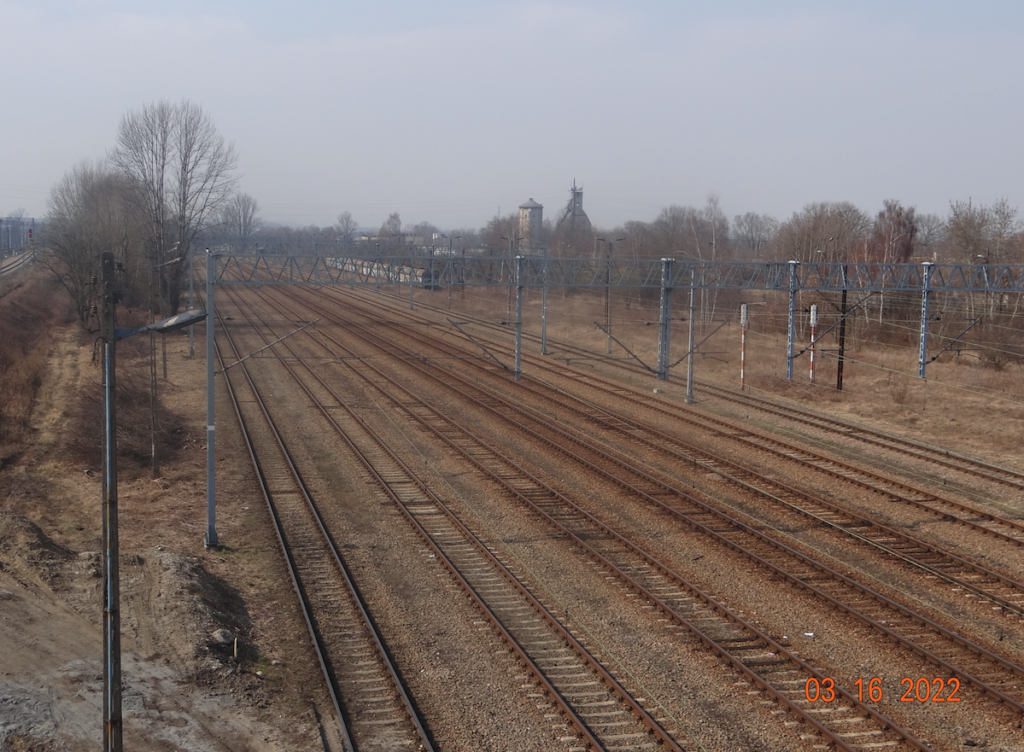
Kraków Prokocim passenger stop.
The Kraków Prokocim passenger stop is described in a separate chapter.
Kraków Bieżanów railway station.
The Kraków Bieżanów railway station is described in a separate chapter.
The longest footbridge in Poland over the tracks.
Geographic coordinates: 50.023N 20.031E.
The longest footbridge in Poland over the railway tracks begins at the Kraków Bieżanów station. The footbridge is 370 m long and begins at Stacyjna Street at the Kraków Bieżanów station. It ends at Magazynowa Street. In the past, there was a lot of pedestrian traffic on the footbridge. Currently, there is little traffic. The footbridge is mainly used by PKP passengers and employees of PKP and the Prokocim Locomotive Depot “PKP IC Zakład Południowy”. It is worth adding that this is not the only facility of this type at the Kraków Prokocim station.
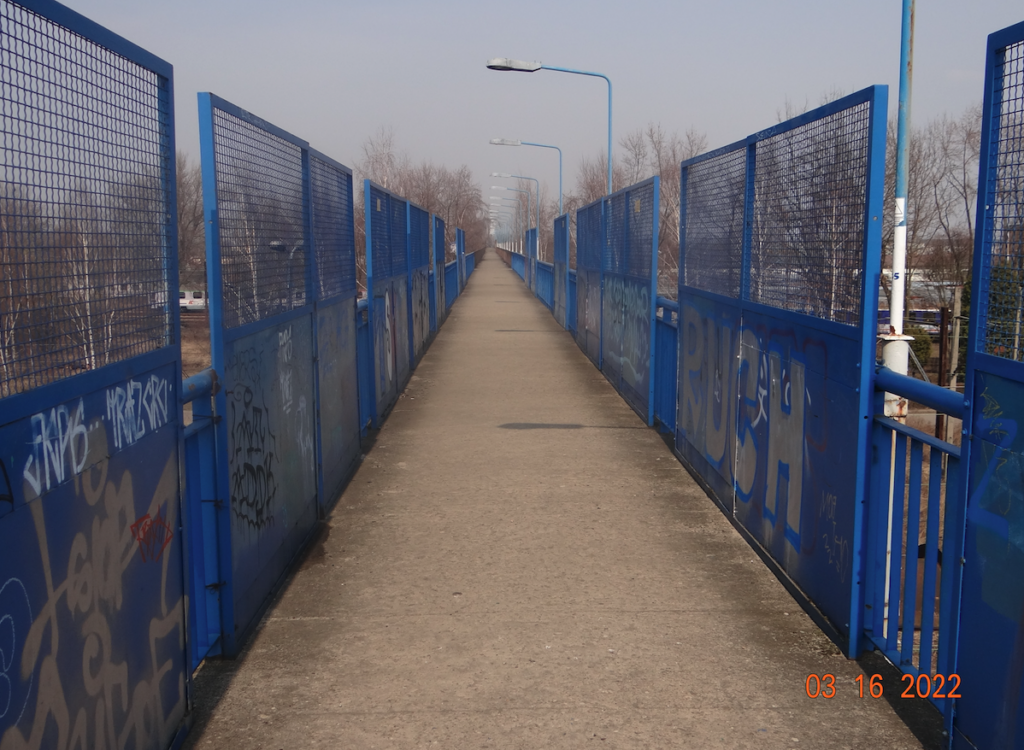
American coal elevator.
Geographic coordinates: 50.024N 20.024E.
The American coal elevator (coal tank) is a huge device designed for coaling, watering and ash removal of steam locomotives. The coal elevator is located at the Kraków Prokocim freight station, near the water tower. The facility was delivered to Poland in its basic elements after World War II as part of UNRRA aid. The tower is manufactured by Ross and White Company from the USA. The elevator at the base is 6 m x 8 m. The total height is 32 m. The volume of the facility is 480 m3. Poland received four devices of this type, which were installed in Tarnowskie Góry, Warsaw (Odolany), Gdynia and Kraków. The advantage of the device was the comprehensive servicing of a steam locomotive within a few minutes. In the classic system, watering and coaling took place in different places. Since the use of steam locomotives in Kraków ceased, the facility has ceased to serve its function. It is not possible to adapt it for other purposes, which is why PKP intends to dismantle it. The facility is a technical monument, but due to its location it is not suitable for viewing by outsiders. It is also not possible to move the facility to another location, due to the cost of such an operation. Because the procedure for liquidating this type of facility is complicated and long, railway enthusiasts can still take many nice photos. However, the facility is located in a closed area and you can get a ticket for entering without permission. It is all the fault of vandals, who paint everything they can, and this is generally not allowed. PKP PLK spends tens of thousands of zlotys every year on removing pseudo-art.
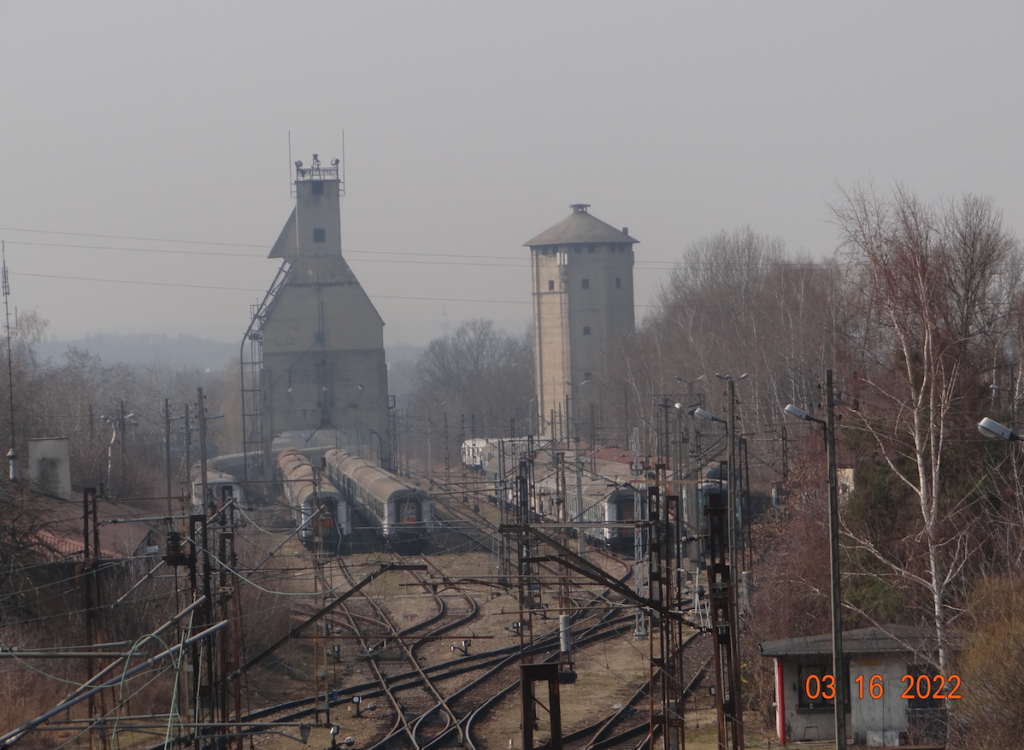
Water tower – Kraków Prokocim.
Geographic coordinates: 50.025N 20.021E.
There have been several water towers in the history of the Kraków Płaszów – Bieżanów railway junction. Two have survived. One double elliptical, the second largest at the Kraków Prokocim Towarowy station, on the premises of the Railway Rolling Stock Repair Plant. The latter, according to some sources, was built during the German occupation, according to others together with the American coal elevator. So, the tower was built in the period 1943 – 1948. The tower is of reinforced concrete construction. It is about 30 m high. Geometrically, it is an octagonal prism, covered with a conical roof. Water for the tank in the tower was taken from the Vistula River from the pumping station, which stands next to the Kraków Zabłocie station. Water could also be drawn from the “Zalew Bagry” reservoir. Currently (2022) the tower serves as a pole for mobile phone antennas.
Prokocim locomotive shed.
Geographic coordinates 50.022N 20.033E.
Currently (2022) it is one of the most modern locomotive sheds in Poland. The facility is managed by PKP IC Zakład Południowy. Address ulica Półłanki 1-3 30-858 Kraków. The locomotive shed is used for servicing and repairs up to level P4 of electric locomotives, mainly EU07, EP07, EP09.
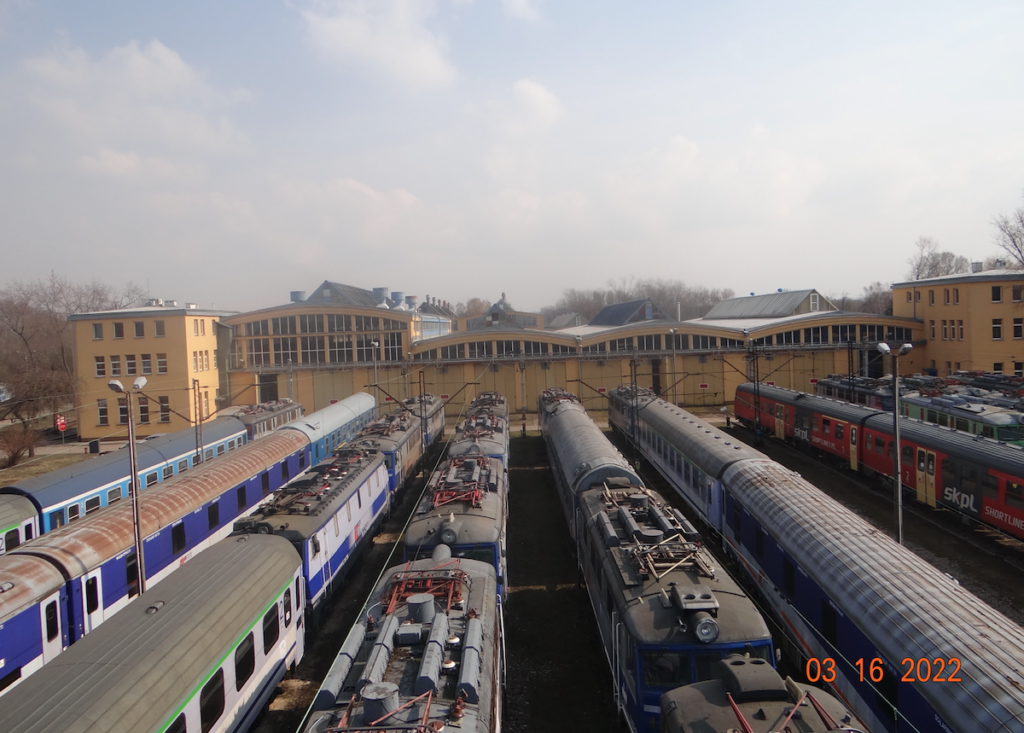
Written by Karol Placha Hetman
